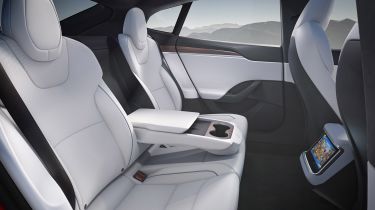Tesla Model S hatchback - Practicality & boot space
The Tesla Model S offers acres of space and a handy ‘frunk’ for extra storage
Inside, the Model S has more luggage space than similarly sized, petrol-powered rivals, as its small electric motor allows for a flat floor and more storage areas. Rear-seat passengers get their own air-con vents and benefit from the full-length glass roof, which makes the interior feel bright and open. Furthermore, the electric motor is positioned behind the rear seats, which keeps the interior floor completely flat and leaves more legroom for whoever's sitting in the middle rear seat.
Boot space
The boot is deep and long, but there’s a lip to lift luggage over. The seats fold flat, although there’s a ridge meaning the floor isn’t all at one level. There’s 894 litres of luggage space altogether – 150 litres of which are in the front where the engine would usually be. Drop the rear seats and space grows to 1,795 litres. That means with the seats up, there’s more space in a Model S than you’ll find in a Mercedes E-Class estate.
If this wasn’t quite enough, under the bonnet, there's another carpet-lined luggage compartment. While this is big enough for a few bags of shopping, there are no outside buttons or switches to open it up, meaning you’ll have to delve into either the Tesla app or the car’s infotainment system to get it open.









